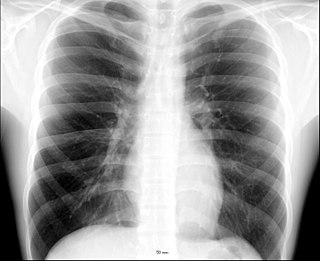
The thorax or chest is a part of the anatomy of mammals and other tetrapod animals located between the neck and the abdomen. In insects, crustaceans, and the extinct trilobites, the thorax is one of the three main divisions of the creature's body, each of which is in turn composed of multiple segments.

The prothorax is the foremost of the three segments in the thorax of an insect, and bears the first pair of legs. Its principal sclerites are the pronotum (dorsal), the prosternum (ventral), and the propleuron (lateral) on each side. The prothorax never bears wings in extant insects, though some fossil groups possessed wing-like projections. All adult insects possess legs on the prothorax, though in a few groups the forelegs are greatly reduced. In many groups of insects, the pronotum is reduced in size, but in a few it is hypertrophied, such as in all beetles (Coleoptera). In most treehoppers, the pronotum is expanded into often fantastic shapes that enhance their camouflage or mimicry. Similarly, in the Tetrigidae, the pronotum is extended backward to cover the flight wings, supplanting the function of the tegmina.
The arthropod leg is a form of jointed appendage of arthropods, usually used for walking. Many of the terms used for arthropod leg segments are of Latin origin, and may be confused with terms for bones: coxa, trochanter, femur, tibia, tarsus, ischium, metatarsus, carpus, dactylus, patella.

Insect wings are adult outgrowths of the insect exoskeleton that enable insects to fly. They are found on the second and third thoracic segments, and the two pairs are often referred to as the forewings and hindwings, respectively, though a few insects lack hindwings, even rudiments. The wings are strengthened by a number of longitudinal veins, which often have cross-connections that form closed "cells" in the membrane. The patterns resulting from the fusion and cross-connection of the wing veins are often diagnostic for different evolutionary lineages and can be used for identification to the family or even genus level in many orders of insects.

This glossary of entomology describes terms used in the formal study of insect species by entomologists.
The notum is the dorsal portion of an insect's thoracic segment, or the dorsal surface of the body of nudibranch gastropods. The word "notum" is always applied to dorsal structures; in other words structures that are part of the back of an animal, as opposed to being part of the animal's ventral surface, or underside.
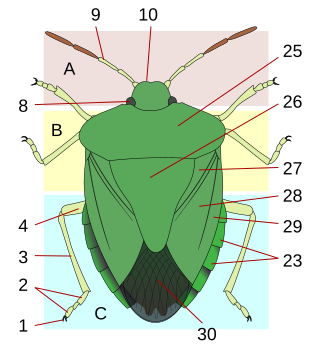
The scutellum is the posterior portion of either the mesonotum or the metanotum of an insect thorax; however, it is used almost exclusively in the former context, as the metanotum is rather reduced in most insect groups. In the Hemiptera, and some Coleoptera, the scutellum is a small triangular plate behind the pronotum and between the forewing bases. In Diptera and Hymenoptera the scutellum is nearly always distinct, but much smaller than the mesoscutum.
The metathorax is the posterior of the three segments in the thorax of an insect, and bears the third pair of legs. Its principal sclerites are the metanotum (dorsal), the metasternum (ventral), and the metapleuron (lateral) on each side. The metathorax is the segment that bears the hindwings in most winged insects, though sometimes these may be reduced or modified, as in the flies (Diptera), in which they are reduced to form halteres, or flightless, as in beetles (Coleoptera), in which they may be completely absent even though forewings are still present. All adult insects possess legs on the metathorax. In most groups of insects, the metanotum is reduced relative to the mesonotum. In the suborder Apocrita of the Hymenoptera, the first abdominal segment is fused to the metathorax, and is then called the propodeum.

The metasoma is the posterior part of the body, or tagma, of arthropods whose body is composed of three parts, the other two being the prosoma and the mesosoma. In insects, it contains most of the digestive tract, respiratory system, and circulatory system, and the apical segments are typically modified to form genitalia. In a few of the most primitive insects, the metasomal segments bear small, articulated appendages called "styli", which are often considered to be vestigial. There are also pre-apical appendages in most insect orders, called cerci, which may be multi-segmented and almost resembling a posterior pair of antennae; these may be variously modified, or lost entirely. Otherwise, most adult insects lack appendages on the metasoma, though many larval insects have some form of appendages, such as prolegs or, in aquatic insects, gills.
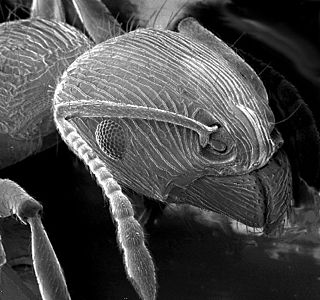
Arthropods are covered with a tough, resilient integument, cuticle or exoskeleton of chitin. Generally the exoskeleton will have thickened areas in which the chitin is reinforced or stiffened by materials such as minerals or hardened proteins. This happens in parts of the body where there is a need for rigidity or elasticity. Typically the mineral crystals, mainly calcium carbonate, are deposited among the chitin and protein molecules in a process called biomineralization. The crystals and fibres interpenetrate and reinforce each other, the minerals supplying the hardness and resistance to compression, while the chitin supplies the tensile strength. Biomineralization occurs mainly in crustaceans. In insects and arachnids, the main reinforcing materials are various proteins hardened by linking the fibres in processes called sclerotisation and the hardened proteins are called sclerotin. The dorsal tergum, ventral sternum, and the lateral pleura form the hardened plates or sclerites of a typical body segment.

Insect morphology is the study and description of the physical form of insects. The terminology used to describe insects is similar to that used for other arthropods due to their shared evolutionary history. Three physical features separate insects from other arthropods: they have a body divided into three regions, three pairs of legs, and mouthparts located outside of the head capsule. This position of the mouthparts divides them from their closest relatives, the non-insect hexapods, which include Protura, Diplura, and Collembola.
This glossary describes the terms used in formal descriptions of spiders; where applicable these terms are used in describing other arachnids.

The thorax is the midsection (tagma) of the hexapod body. It holds the head, legs, wings and abdomen. It is also called mesosoma or cephalothorax in other arthropods.
Dipteran morphology differs in some significant ways from the broader morphology of insects. The Diptera is a very large and diverse order of mostly small to medium-sized insects. They have prominent compound eyes on a mobile head, and one pair of functional, membraneous wings, which are attached to a complex mesothorax. The second pair of wings, on the metathorax, are reduced to halteres. The order's fundamental peculiarity is its remarkable specialization in terms of wing shape and the morpho-anatomical adaptation of the thorax – features which lend particular agility to its flying forms. The filiform, stylate or aristate antennae correlate with the Nematocera, Brachycera and Cyclorrhapha taxa respectively. It displays substantial morphological uniformity in lower taxa, especially at the level of genus or species. The configuration of integumental bristles is of fundamental importance in their taxonomy, as is wing venation. It displays a complete metamorphosis, or holometabolous development. The larvae are legless, and have head capsules with mandibulate mouthparts in the Nematocera. The larvae of "higher flies" (Brachycera) are however headless and wormlike, and display only three instars. Pupae are obtect in the Nematocera, or coarcate in Brachycera.

Zigrasimecia is an extinct genus of ants which existed in the Cretaceous period approximately 98 million years ago. The first specimens were collected from Burmese amber in Kachin State, 100 kilometres (62 mi) west of Myitkyina town in Myanmar. In 2013, palaeoentomologists Phillip Barden and David Grimaldi published a paper describing and naming Zigrasimecia tonsora. They described a dealate female with unusual features, notably the highly specialized mandibles. Other features include large ocelli, short scapes, 12 antennomeres, small eyes, and a clypeal margin that has a row of peg-like denticles. The genus Zigrasimecia was originally incertae sedis within Formicidae until a second species, Zigrasimecia ferox, was described in 2014, leading to its placement in the subfamily Sphecomyrminae. Later, it was considered to belong to the distinct subfamily Zigrasimeciinae.
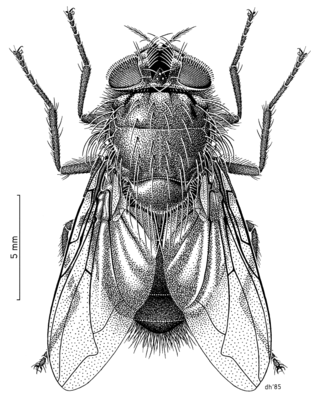
Calliphora quadrimaculata, commonly known as the New Zealand blue blowfly and by its Māori name rango pango, is an insect in the genus Calliphora of family Calliphoridae in the order Diptera. This particular blowfly is found throughout New Zealand as well as on Chatham, Auckland, Stewart and Campbell Islands that surround New Zealand. Generally blowfly maggots in New Zealand have to feed on animal tissue or faeces to develop into adult blowflies. However the New Zealand blue blowfly larvae can survive on decaying leaves of snow tussock in alpine regions and reach adult maturity without feeding on any animal tissue.

Eristalis flavipes, the orange-legged drone fly, is a species of hoverfly native to North America. It flies from early April to mid-October, and occurs in a wide variety of habitats, particularly wetlands. Hoverflies get their names from the ability to remain nearly motionless while in flight. The adults are also known as flower flies for they are commonly found around and on flowers, from which they get both energy-giving nectar and protein-rich pollen. The larvae are aquatic filter-feeders of the rat-tailed type.

Caenocholax fenyesi is a species of twisted-winged parasitic insects in the order Strepsiptera and family Myrmecolacidae. It has a sporadic distribution throughout North America, Central America, and South America. Chaenochlax brasiliensis is the only other named species in the genus.
Zaitzevia elongata is a species of riffle beetle which is wingless and flightless. It is found on several of the Ryukyu Islands in Japan in the gravel substrate of streams.
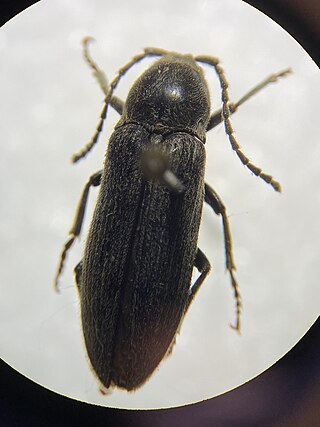
Perothops is a genus of false click beetles in the family Eucnemidae containing 3 species. They are known as beech-tree beetles or perothopid beetles. They are small as they are only 10–18 millimeters long. It is the only genus in the monotypic subfamily Perothopinae. They are dark-colored beetles that are found across the United States, generally in forests. The genus was discovered by Johann Friedrich von Eschscholtz in 1836. It used to be considered a family not part of Eucnemidae. The genus's name is from Greek, translating to "maimed/crippled eye" or "eye of little necklaces/bands", referring to the placement of perothopid eyes.













